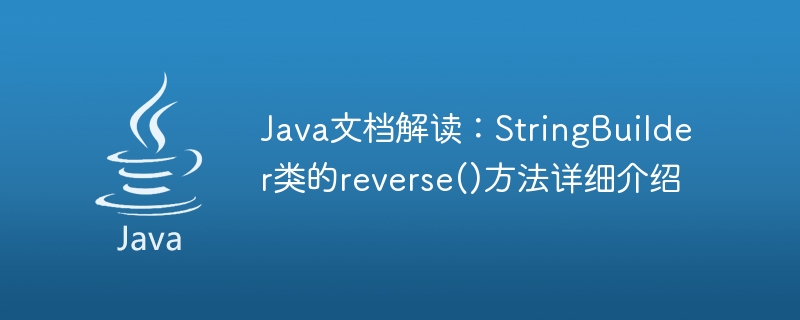Home >Java >javaTutorial >Interpretation of Java documentation: Detailed introduction to the reverse() method of the StringBuilder class
Interpretation of Java documentation: Detailed introduction to the reverse() method of the StringBuilder class
- WBOYWBOYWBOYWBOYWBOYWBOYWBOYWBOYWBOYWBOYWBOYWBOYWBOriginal
- 2023-11-04 14:45:291937browse

Interpretation of Java documentation: A detailed introduction to the reverse() method of the StringBuilder class, specific code examples are required
Introduction:
In Java programming, characters String is a common data type. To operate and process strings, Java provides many built-in classes and methods. Among them, the StringBuilder class is a very useful class that allows us to dynamically modify and transform strings. In this article, we will delve into the reverse() method of the StringBuilder class, which can be used to reverse the order of a string.
StringBuilder class introduction:
The StringBuilder class is a variable string class in Java. Unlike the String class, the StringBuilder class can modify the contents of a string without creating a new string object. The StringBuilder class is the first choice for string operations, especially when frequent string concatenation and modification are required, because it is more efficient than the String class.
Function of the reverse() method: The
reverse() method is a powerful method provided by the StringBuilder class, which can reverse the order of characters in a string. This is very useful for scenarios that require reverse operations on strings, such as password encryption, string reversal, etc. The reverse() method has no return value, it directly modifies the original string.
Method signature:
public StringBuilder reverse()
Method interpretation and sample code:
The following is a detailed interpretation of the reverse() method, at the same time A practical code example is given:
public class ReverseStringExample {
public static void main(String[] args) {
StringBuilder sb = new StringBuilder("Hello World!");
System.out.println("原字符串:" + sb);
sb.reverse();
System.out.println("颠倒后的字符串:" + sb);
}
}In the above code example, first we create a StringBuilder object sb and initialize it with the string "Hello World!" We then use the reverse() method to reverse the string and print the result. Executing the above code will output the following results:
原字符串:Hello World! 颠倒后的字符串:!dlroW olleH
It should be noted that the reverse() method will directly modify the original string and has no return value. Therefore, we can perform the next step directly based on the original string without creating a new string object.
Summary:
In this article, we introduced in detail the reverse() method of the StringBuilder class in the Java document. With this method, we can easily reverse the order of the string without creating a new string object. The reverse() method is very useful in scenarios such as password encryption and string reversal. I hope this article will help you understand and use the reverse() method in the StringBuilder class. If you are not familiar with Java string operations, it is recommended to practice more to deepen your understanding.
The above is the detailed content of Interpretation of Java documentation: Detailed introduction to the reverse() method of the StringBuilder class. For more information, please follow other related articles on the PHP Chinese website!
Related articles
See more- Interpretation of Java documentation: Detailed introduction to the delete() method of the StringBuilder class
- Java documentation interpretation: Usage analysis of nextBoolean() method of Scanner class
- Interpretation of Java documentation: Analysis of the functions of the exists() method of the File class
- Interpretation of Java documentation: Functional analysis of the valueOf() method of the Short class
- Java documentation interpretation: Detailed description of the random() method of the Math class

